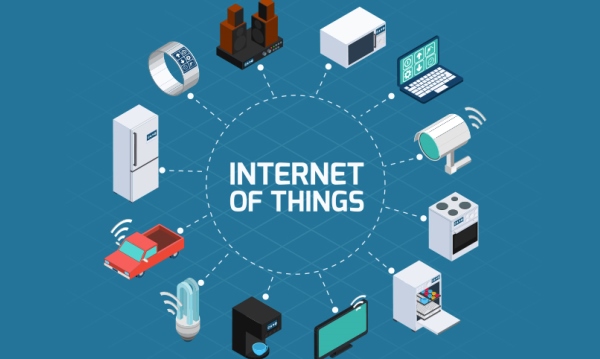News
IoT Growth Expected to See more than 50bn Connected Devices in Next Decade

By Willie Oosthuysen
IOT is expected to drive the proliferation of connected devices from about a billion plus today to over 50 billion in the next decade.

While the Internet of Things (IoT) may still be an emerging technology, it is difficult to dispute that it has become deeply entrenched in people’s lives and its proliferation is likely to accelerate even further in the next few years.
The First Industrial Revolution, which saw the development of machine tools and the rise of the mechanised factory system, had an unprecedented effect on the way people worked and lived, leading to a massive rise in the rate of population growth.
Similarly, the Fourth Industrial revolution is expected to have an equally profound and irreversible impact on all aspects of society, as it gathers momentum.
According to industry experts, IoT is rapidly driving the adoption of connected devices, from about a billion-plus today to over 50 billion in the next decade. This includes devices such as smartphones, vehicles, electronic appliances, as well as smart sensors that are connected to a wireless network.
South Africa is a clear leader in some use cases of the IoT space with applications such as stolen vehicle recovery, security and cash-in-transit management systems. However, the areas where we are playing catch-up are autonomous vehicles and clean energy generation and distribution, among others.
There are at least four areas of IoT that have so far affected people’s lives most significantly:
- Connected homes
This is where we started feeling the effects of IoT most directly. Connected homes contain Intelligent systems, such as remote controlled and accessed cameras, fire detection systems, smart lighting systems and other security features, which are connected to the internet.
In the past, homeowners who had video cameras installed would have to be at home in front of a screen to monitor them. These days, you can monitor your cameras via your phone, or even perform other functions, such as unlocking the door or switching on the lights or pool pump remotely.
A lot of home automation and entertainment systems are now connected to the internet and leverage connectivity for people to be able to use them effectively.
- Connected vehicles
Vehicle recovery systems have evolved into telematics and logistics management, which helps with routing and scheduling and other functions of fleet logistics designed to optimize the delivery of cargo.
Connected vehicles applications are very specific and are either built into cars or smartphones, which shows that mobility has added a lot to the utilisation and adoption of IoT technologies.
Car manufacturers are also increasingly able to monitor how cars are driven and whether they need any specific type of maintenance, before anything goes wrong. They can also pre-order the requisite parts, which improves the speed and efficiency of services or repairs. Other connected car applications deal with safety and navigation, among others.
- Wearables
These include wearable devices that can monitor your heart rate, measure exercise and sleep, and even monitor your health in general.
This form of IoT technologies is far more personal and adoption is still quite low. However, the applications are numerous, especially in the healthcare and fitness space.
In addition, wearable devices can also be used for children tracking, as well as other kinds of applications that are related to safety and well-being. It is in the applications and the data that the real value of IOT exists, not in the sensors or the networks that transport the signals.
- The Industrial internet
The industrial internet, which used to be known as machine automation or machine-to-machine communication, is the oldest form of IoT, and is by far the biggest market in IOT in South Africa.
Essentially, the industrial internet refers to the integration and linking of big data, analytical tools and wireless networks with physical and industrial equipment, such as the use of robotics in manufacturing or process control automation in petro-chemical plants.
The industrial internet has been having a significant impact on our lives for many years now through the automation of industrial functions. However, as consumers, we haven’t really felt this impact directly.
Proliferation of IoT
The rate of innovation, ingenuity and scope that has been driven by IoT has been nothing short of remarkable and businesses are continually developing more and more ways to connect us. Within the next few years, it is predicted that the proliferation of sensors is likely to see them permeate every aspect of our lives.
In terms of South Africa’s adoption of IoT technologies, there are areas in which we are significantly ahead of the rest of the world and others where we are behind, but we cannot afford to fall behind.
The potential of IoT is simply limitless and holds great promise for improving our quality of life and bringing about profound changes in the way we work.
Willie Oosthuysen, is Chief Strategic Business Officer at Liquid Telecom
News
LG Launches “Radio Optimism” Campaign to Spread “Life’s Good” Through Music

LG Electronics has launched a new brand campaign, “Radio Optimism,” designed to help strengthen meaningful human connections and spread optimism through shared musical experiences.

This initiative aligns with LG’s brand promise, “Life’s Good,” and addresses the growing challenge of forming genuine relationships in a technology-driven world.
The Radio Optimism campaign seeks to counteract the disconnection often felt in an era dominated by superficial interactions, such as likes and comments on social media. By harnessing the power of music, LG aims to foster deeper bonds among individuals, promoting a more fulfilling life.
“As technology advances, meaningful human connections become increasingly vital to enrich our lives. LG continues its commitment to bringing optimism into customers’ daily lives, staying true to our enduring brand promise of ‘Life’s Good,’” said Kim Hyo-eun, head of LG’s Brand Management Division.
This campaign reinforces LG’s commitment to creating enriching experiences in digital spaces where today’s consumers spend significant time. Building on this mission, LG has continuously engaged with younger audiences through participatory campaigns that bring the Life’s Good philosophy to life.
Last year’s “Optimism your feed” campaign leveraged social algorithms to foster positivity on social media. This new initiative specifically seeks to address the paradoxical disconnection in an era of hyper-connectivity.
“One of the most reliable predictors of happiness is having deep and meaningful relationships,” said Jean M. Twenge, Professor of Psychology at San Diego State University. “Yet today, many people are spending more time online and less time connecting in person. Social media in particular tends to create shallow relationships rather than the deep connections people need.
“It’s common for people to have hundreds of followers but no one to talk to in real life if they need support. We need to build more meaningful connections with those around us. That might turn around the pronounced decline in happiness that’s occurred over the last decade.”
A new global study* from LG on social connection reveals that 68 percent of people find it harder to make real friends, and a third reported having one or fewer meaningful connections in the past month, with 8 percent experiencing none at all.
Inspired by traditional radio’s unique way of connecting people through music and storytelling, the Radio Optimism campaign transforms this concept into an interactive platform where participants can create and send personalized songs to their loved ones.
Users can easily create new songs using AI-powered tools, which are thoroughly trained on a curated music dataset. These tools interpret user prompts to produce unique musical pieces and generate matching album art, providing an engaging and personalized experience. Once generated, these songs can be sent to recipients to deepen their connection and made available for others to discover worldwide.
According to the survey, nearly 9 in 10 respondents believe that meaningful connections lead to a more optimistic outlook on life. By providing a platform for individuals to express their feelings, this campaign aims to foster deeper connections and help individuals enrich their lives while spreading optimism in their own ways.
The campaign website is available in English and Spanish, with plans to support additional languages in the coming months to enable broader participation. The official website can be found at RadioOptimism.lg.com.
News
Nigeria’s Electricity Output Climbs 10.92% in Q1 2025, Boosted by Thermal Plants

Nigeria’s electricity generation rose by 10.92% in the first quarter of 2025, driven by improved operational capacity and better availability of thermal and hydropower plants supplying the national grid.

This is according to the latest report from the Nigerian Electricity Regulatory Commission (NERC) for Q1 2025.
Total energy generated stood at 10,304.47 gigawatt-hours (GWh), up from 9,289.95 GWh recorded in the previous quarter. The increase highlights stronger performance across multiple power plants, supported by improved grid dispatch conditions.
NERC noted that average hourly generation on the grid also grew by 13.39%, rising to 4,770.59 megawatt-hours per hour (MWh/h) from 4,207.41 MWh/h in Q4 2024—an increase of 563.18 MWh/h.
“The hourly generation and the total generation increased by 13.39% and 10.92% respectively in Q1 2025 compared to Q4 2024. This rise is linked to an increase in the cumulative available generation capacity of grid-connected plants,” the report stated.
A total of 19 power plants boosted their output during the quarter, contributing significantly to the overall rise in generation.
Thermal power plants were the main drivers of growth. Out of the 23 thermal plants connected to the grid, 16 recorded higher average hourly output compared to the previous quarter.
Top contributors included Delta_1, which added 157.58 MWh/h, followed by Geregu_2 (71.95 MWh/h), Egbin_1 (68.20 MWh/h), and Afam_2 (68.03 MWh/h).
Hydropower plants also supported the growth, though at a smaller scale. The five grid-connected hydro stations posted a combined increase of 54.93 MWh/h, marking a 4% improvement. Zungeru_1 led with a 23.55% rise, while Shiroro_1 and Kainji_1 grew by 12.21% and 4.80% respectively.
This first-quarter improvement reflects ongoing efforts to stabilize power supply through better plant maintenance, enhanced grid management, and more consistent dispatch across regions.
However, challenges such as fuel supply to plants, equipment reliability, and high operating costs continue to limit the full potential of Nigeria’s power generation capacity.
News
DBI, Miva Open University Partner to Advance Digital Innovation, Education

Digital Bridge Institute (DBI) and Miva Open University, Abuja, have signed a Memorandum of Understanding (MoU) to jointly promote digital technology and academic excellence in computer science and innovation.

Mr. David Daser, president/CEO, DBI, and Professor Tayo Arulogun, vice chancellor, Miva Open University.
DBI, a Federal Government-owned ICT training institute with headquarters in Abuja and campuses across Nigeria’s six geo-political zones, hosted the signing ceremony at its headquarters.
The MoU marks a significant step in formalizing and strengthening the existing relationship between the two institutions.
Signing on behalf of their institutions were
Speaking during the event, Mr. Daser praised Professor Arulogun’s leadership and commitment to academic development, which he said made the partnership possible. He emphasized that unlike many MoUs that remain inactive, this collaboration is set to deliver tangible results.
“We value this partnership and are confident it will meaningfully contribute to Nigeria’s education sector. DBI is fully prepared to implement the agreement and drive an impact across our campuses in Enugu, Abuja, Kano, Lagos, Asaba, and Yola,” Daser said.
He added that the collaboration would strengthen DBI’s National Innovation Diploma (NID) program and other initiatives through shared resources and new opportunities.
Professor Arulogun, in his remarks, highlighted the need for greater collaboration among Nigerian universities, criticizing the prevalent “do-it-alone syndrome.”
“Many institutions prefer to operate in silos, but collaboration is key. Pooling resources and working together will enhance capacity and academic output,” he stated. “With this partnership, we are ready to hit the ground running from student exchange to joint innovation projects like hackathons.”
He noted that hackathons provide platforms for discovering hidden talents and fostering innovation, and Miva is eager to integrate such activities into its academic programs.
Mr. Emeka Nzeih, head of Learning and Development, DBI, outlined the partnership’s key focus areas: student internships, real-world project collaborations, joint research in fields like AI, robotics, and cybersecurity, and shared access to DBI’s ICT labs and equipment for Miva’s students and faculty.
According to Nzeih, the initiative aims to enhance practical learning, foster innovation, and build capacity through collaborative training, research, and mentorship.

 Telecom2 days ago
Telecom2 days agoMTN Nigeria Debuts Game-Changing CPaaS Platform at NextNow Forum

 News2 days ago
News2 days agoAMCON Confirms ₦100Bn Sale of Ibadan DisCo Amid Legal Disputes

 E-Financial1 day ago
E-Financial1 day agoCourt Affirms NIBSS Authority to Manage BVN

 E-Financial2 days ago
E-Financial2 days agoNAICOM Issues New Licenses to SanlamAllianz Life, General Insurance

 E-Business2 days ago
E-Business2 days agoDomain of Deception as Attackers Deploy Spyware Under Guise of Legal Threats

 E-Financial2 days ago
E-Financial2 days agoGTCO to Become First Nigerian Bank to List on London Stock Exchange

 Telecom1 day ago
Telecom1 day agoMTN, 9mobile Commence Ground-breaking National Infrastructure Partnership

 Broadcasting2 days ago
Broadcasting2 days agoIFC, AfDB Collaborate with EbonyLife Media to Explore Supporting the African Film Industry to Drive Job Creation























